Spring 2013 A publication of the Wildlife Division—Getting Texans Involved
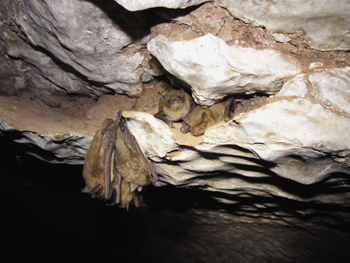 Searching Texas Caves for Signs of WNS
Searching Texas Caves for Signs of WNS
Photo © Merlin D. Tuttle, Bat Conservation International, www.batcon.org
By Mylea Bayless
Iclimbed slowly and cautiously down the ledge that February day. My reward, after three days of cold, wet and exhausting underground surveys, was the biggest hibernating bat colony we've found yet. I'm sweating in the cold from anticipation and exertion. But the sight revealed by our roving headlamps was breathtaking: the ceiling of this chamber was covered with hibernating cave myotis (Myotis velifer), a dense expanse of brown fur pocked with countless noses, ears and wrists. This was the largest colony I had ever seen in northwest Texas. Then, as we began counting bats, I found a special treat - a white spot in the sea of brown. It's not every day you get to see an albino bat!
We were surveying select north Texas caves for the presence of hibernating bats and for the dreaded signs of White-nose Syndrome. In four busy days, we surveyed 10 caves and counted more than 8,600 bats. Much smaller numbers of tri-colored bats (Perimyotis subflavus) and Townsend's big-eared bats (Corynorhinus townsendii) share many of the hibernation caves with cave myotis colonies. Thankfully, we found no sick or dying bats and no evidence of WNS or the Geomyces destructans fungus that causes it.
Scientists throughout the American West are conducting similar surveys, searching for evidence they hope never to find, while nervously preparing for the potential arrival of this dire threat that has devastated bat populations in the East. White-nose Syndrome or the fungus has now been confirmed in nine bat species in 21 U.S. states and 4 Canadian provinces.
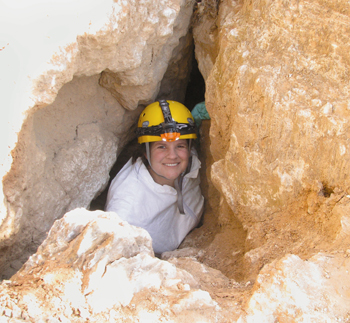
Photo © Yazmin A. Avila, Bat Conservation International, www.batcon.org
Northwest Texas is directly in one of the most likely paths as WNS expands into the America West, and may be at particular risk. The WNS fungus was reported from cave myotis in an Oklahoma cave in 2010, although no sign of disease has been identified and the fungus has not been detected since then. Researchers are uncertain how the fungus or the disease might impact western bat species, which typically form smaller, more scattered colonies than most cave-hibernating eastern bats.
Also, the Oklahoma cave was home to Mexican free-tailed bats (Tadarida brasiliensis) as well as cave myotis. The freetails, which do not hibernate, are likely to be spared the devastation of WNS. They might, however, be able to transport the fungus - and this is a very widespread species that migrates 1,000 miles (1,600 kilometers) or more into Latin America, which is so far untouched by WNS.
Our team needed to count the bats we were surveying. That is a surprisingly difficult task, even when the hibernating bats hang perfectly still on cave walls. They cling together in clusters, each bat tucked tightly against its neighbors to maximize temperature stability. Counting a small group of, say, 20 to 50 bats can be accomplished by just looking carefully and quietly with a flashlight. But things get complicated when you're faced with clusters of hundreds or thousands of bats, and even experienced observers often come up with widely varied counts. We photographed these large clusters, then checked our initial estimates by displaying the digital photos on a computer screen and meticulously counting each bat. Still, we are unlikely ever to achieve 100 percent accuracy - you just can't see the bats hidden behind their neighbors - but this added step has improved our results.
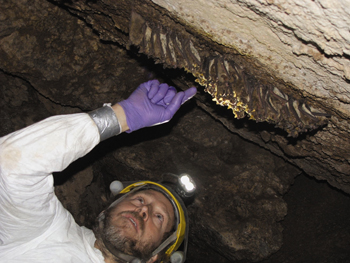
Photo © Mylea Bayless, Bat Conservation International, www.batcon.org
In this troubling time of White-nose Syndrome, the decision on whether to enter a hibernation cave is never taken lightly. We constantly evaluate the trade-off between the need for accurate data and the risk of disturbing the bats, which can cause individuals to arouse from hibernation and deplete the critical fat reserves they need to survive the winter. Now we must also consider the additional risk that simply entering the cave could inadvertently help spread the WNS fungus. We now spend hours carefully cleaning and disinfecting our gear to standards set by the U.S. Fish & Wildlife Service, and we decide not to enter some caves at all.
Yet just as the threat of WNS raises the risk of entering caves, it can also greatly increase the need to do so, albeit with great care and consideration. The number of bats hibernating in a site and the complexity of their underground environment are critical in setting priorities for limited conservation dollars. And in most Western states, information about the locations of bat hibernacula and their relative importance is very limited.
The risk posed by WNS drives BCI and our partners to explore alternatives for counting bats. Remote monitoring technologies such as thermal imaging, acoustic monitoring, infrared beam-break systems and doppler radar ultimately may let us survey caves without entering them, but most systems still need additional testing and development before they will be available for general use.
In the meantime, we still have many more questions than answers about Western bat populations and about cave myotis in Texas, but we are making progress. Cave myotis are colonial, insect-eating bats that usually roost in caves and mines (and occasionally buildings and bridges) throughout the southwestern United States and Mexico. Some cave myotis colonies are known to migrate in spring and fall, while others do not. The reasons for such differences among colonies are not clear.
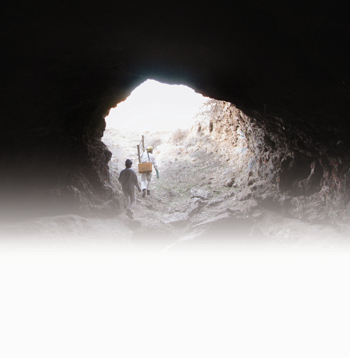
Photo © Mylea Bayless, Bat Conservation International, www.batcon.org
Biologists are increasingly concerned that these populations may be declining - well before the potential arrival of WNS - because many known roosts apparently have been abandoned. But perhaps they are simply shifting roosts. In Texas, we hope to find some answers by periodically surveying a rotating inventory of hibernacula each winter. This should also provide an early warning of the presence of WNS. BCI is working with a number of partners on similar surveying programs for other bat species around the West, where the specter of White-nose Syndrome is a constant fear.
Walking into one of those great rooms deep underground sometimes makes me feel insignificant. I become instantly aware that my whole life is just a fraction of a second compared with the timeline of this one chamber. The bat colony clinging to the rocky ceiling has probably been using this room for many of my lifetimes. The individuals in the colony change, but the colony itself persists. How many centuries did the bats need to create this mountain of guano on the cave floor? Bats have been roosting here so long that they have permanently stained the rock a deep reddish-brown. I am inspired when I think of this enduring ecosystem. And I am saddened to think that in a few short decades, many of these cave rooms filled with bats might sit empty because of WNS.
We must not let that happen. Throughout North America, dedicated bat conservationists and scientists are working tirelessly to ensure that these underground rooms will forever be filled with bats.
Mylea Bayless is Director of Conservation Programs at Bat Conservation International working out of Austin.
You can help Bat Conservation International and its partners fight the scourge of White-nose Syndrome and other devastating threats against bats. Please show your support at www.batcon.org/donate.
Beauty in the Evening
By Anna Strong
In fact, darkness in itself is not enough while wrangling bats. Because predatory owl eyes are adjusted to the dark, a moonless night is preferred. On nights so dark your depth perception is impaired we would erect a very delicate, badminton-like net near an agave and then wait. Only when a Mexican long-nosed bat would entangle itself in the net, could a dim red light be turned on to take data and release the bat from the claws of the very thin, very tenacious net. Which is why while stumbling around the net, my immobile agave friends would periodically remind me of their important role in bat ecology by discourteously lodging a stout spine in my shin.
Not to be forgotten in their immobile rooted state, agaves, like all plants, do undergo movements. Most likely the movement of the agave spine at night was a trick of the light, but plants can move. One type of movement, called nyctinasty, is in response to the cycle of the sun. For example, Texas bluebonnets (Lupinus subcarnosus) fold their leaves in reaction to the setting sun, as if curling up to go to bed. At the same time, other plants are just starting their shift, and begin to open their flowers at dusk. Some night-blooming plants open in response to the setting sun and stay open only at night. Other night-blooming plants stay open at night and during the day.
Night bloomers, just like their daytime counterparts, provide food for pollinators. Many night-blooming flowers are light-colored to assist pollinators in locating blooms. However, other than their habit of opening up at dusk, these plants are as varied as the pollinators which assist them in producing seed. Texas night-bloomers occur all over the state in multiple plant families, from the lilies to the cacti, and from the evening primroses to the four-o'clocks. Some of these plants, including information on their appearance and pollinators, follows.
Four-o'clock Family (Nyctaginaceae)
As is indicated by their name, many (but not all) plants in the four-o'clock family open in the afternoon.
- Two West Texas four-o'clocks, angel trumpets (Acleisanthes longiflora) and sweet four-o'clock (Mirabilis longiflora), have white, tubular flowers that can grow over 6 inches in length. The slender flowers of angel trumpets may be pollinated by hawkmoths with a super-sized "tongue", or proboscis, but strangely enough will more likely not open at all and self-pollinate instead.
- The scarlet musk-flower (Nyctaginia capitata) in western and southern Texas has a handsome display of showy red flowers that commonly open after a rainfall and can stay open into the next day. However, at close range, this plant evokes an unpleasant odor, at least to the bipedal passersby.
Dogbane Family (Apocynaceae)
- Woolly rocktrumpet (Telosiphonia lanuginosa) occurs in south Texas and has long, slender trumpet-shaped flowers, which produce bean-like seed pods. The pods open up to release seeds with long hairs like a dandelion seed. The wind can then pick up the seed and carry it far from the parent plant.
Evening Primrose Family (Onagraceae)
Many flowers, including some evening primroses, will change color in response to being pollinated, which encourages insects to visit another unpollinated flower instead.
- Havard's evening primrose (Oenothera havardii) of West Texas has flowers which change from yellow to reddish before they wilt.
- The spotted primrose (Oenothera canescens) of the High Plains is pink with white and reddish-purple spots. The flowers are visited by noctuid moths, which avoid daytime predators by feeding at night. To avoid nighttime predators, specifically bats, moths can respond to nearby echolocating bats by flying erratically or folding their wings to simply fall.
Although both Havard's evening and spotted primrose have flowers that open during the evening, there are also evening primroses that bloom during the day.
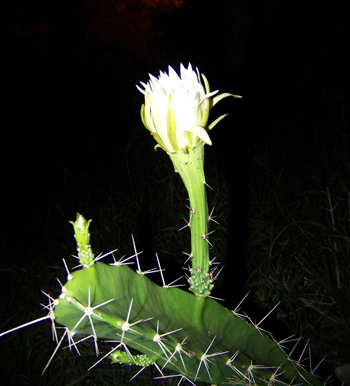
Cactus Family (Cactaceae)
- Hawkmoths visit the dramatic white blooms of the barbed-wire cactus (Acanthocereus pentagonus) of southern Texas. Flowers are located by smell and sight. From long distances, hawkmoths can detect plants by the flower's fragrance and zero in on individual flowers by sight. Unlike humans, hawkmoths can see color differences at night, which enables them to differentiate varying colored flowers and flowers amongst neighboring leaves.
Century Plant Family (Agavaceae)
- Like many century plants, Havard's century plant (Agave havardii) only lives 20-40 years, instead of the 100 the family name proclaims. However, when the plant does send up its 15 foot yellow flower stalk, the Mexican long-nose bat, along with doves and orioles, feed on the nectar and pollen of the plant. Bats and birds are necessary for carrying agave pollen the long distance between individual plants to pollinate other agave flowers.
It is easy to forget about the important role plants play because they are not warm and fuzzy, nor do they appear to move. To make matters worse, flowers that bloom at night are all but forgotten because of human's inability to see colors in the dark. The truth is that plants have figured out how to communicate with animals to encourage visitation (and even discourage visitation!) and aid in movement. In many ways plants have ingenious ways of getting bats, moths, and even the wind to do some work for them. The next time you are out at night with your colorblind-self, you best remember about your night-blooming friends. Otherwise, one might decide to discourteously remind you.
Anna is a grant specialist with Texas State University working out of Texas Parks and Wildlife offices in Austin.
Things That Go Bump (and Click and Quonk and Burp...) in the Night
By By Lee Ann Johnson Linam
Then, from just over the fence-line, comes a sound that raises the hairs on the back of your neck. Kind of an "oooooh" ghostly sound-starting low and rising higher. Then it is joined by an alien-like "wop, wop, wop." And then, in the roadside ditches a pulsing whirr begins-like the blades of a helicopter-and it just goes on and on for what seems like forever! You jump in your car and decide to take your chances with the tire noise-no alien encounters of the third kind for you tonight!
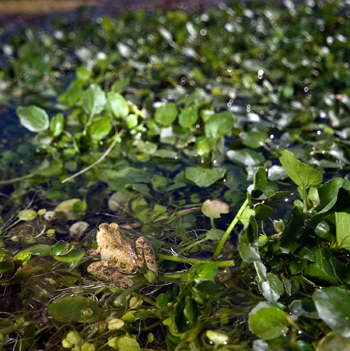
Actually, you've just had an anuran encounter of the South Texas kind... with three unique sounds that occur only in South Texas and only after heavy rains. And, believe it or not, the spooky moans and trills are the love songs of the frog world - sung at night by males at breeding locations (such as ponds and ditches) when temperature, humidity, and rainfall conditions are just right.
Frogs are truly the songsters of the night. Archie Carr, renowned Florida herpetologist, said, "Frogs do for the night what birds do for the day: They give it a voice. And the voice is a varied and stirring one that ought to be better known." So, how do we begin to "know" the voice of our 40+ Texas frogs and toads?
One way, of course, is to get out there and listen at night. But, just like learning bird calls, it helps to try to group species with similar calls and then describe them as some other familiar noise we know. Just for fun, let's start with the "Moaners" - a group I sometimes like to call "Farm Animals in Distress." For example, the Sheep Frog found in South Texas sounds just like that - an angry, bleating sheep - one that bleats for a l-o-n-g time. On the other hand the Woodhouse's Toad, found throughout much of the state, has a short, flat, uninspired bleat; the Couch's Spadefoot sounds like someone might be squeezing a sheep, and the Hurter's Spadefoot is a sheep that's giving up. The Eastern narrowmouth toad, which might be considered a "moaner" actually sounds most like a basketball buzzer going off!
Many of the toads are "Trillers" - producing a trill that is somewhat insect-like. It helps to pay attention to the pitch and duration of the trill. Gray treefrogs have a short single trill, while Texas toads have a short pulsing trill-like the pattern of a rivet gun. Houston toads, American toads, and red-spotted toads sing a long, high musical trill, while the trill of the ubiquitous Coastal Plains toad is lower and much less melodic. Go a little lower and a little more tone-deaf and you get the Great Plains toad.
Another group on the melodic end of the spectrum are the "Peepers" - named for the clear, high bell-like sound of the spring peeper. Drop the bell's pitch a bit and you get the Strecker's chorus frog. Both of these species actually sing mostly in the winter and early spring, and large groups of frogs singing together take on their own sound - the sound of sleigh bells for spring peepers and the sound of an axle in need of grease in the case of the Strecker's. In the warmer months one might hear the peeps and short trills of the cliff chirping frog in the Edward's Plateau, the spotted chirping frog in the Trans-Pecos, or the Rio Grande chirping frog, widely introduced across the state, whose call has been described as sounding like tennis shoes on a gym floor.
At the less musical (but equally delightful) end of the spectrum are the "Burpers" - those frogs that sound like... well, you know. Plains spadefoot toads and crawfish frogs give short burps. Pickerel frogs sound more like a snore (and can sing from underwater!). And the leopard frogs - well, they take the basic burp sound and have fun with it, adding chuckles, purrs, grunts, squeaks-with the proportion of those sounds helping you sort out between the three different leopard frog species in different parts of the state.
Some frog sounds might be described as "Insect-like," but, thankfully, many of those insect-like frogs actually create a readily distinguishable sounds. For example, the cricket frog sounds like two marbles being clicked together. The spotted chorus frog sounds like you are rubbing your fingers over the small teeth of a comb, the Cajun chorus frog sounds like you're using the big teeth of the comb, and the New Mexico spadefoot sounds like you're using a really big comb! There are also the "angry-insect" frogs - the green toad sounds like an angry bee, while the Great Plains narrowmouth produces a higher-pitched angry buzz, somewhat like the trick buzzers people hold in the palm of their hand.
And then there are those frogs and toads that just have their own unique sound. Bullfrogs sound like someone blowing over the top of a bottle. Green frogs sound like plucking a loose banjo string. Green treefrogs sound somewhat goose-like, but really sound like the alien creatures in the movie Mars Attacks! And pig frogs sound like pigs, squirrel treefrogs sound like squirrels, and barking frogs sound like dogs.
Thankfully, you never have to choose between 40+ different frog sounds on any one given night. Species each have their own ranges within the state, breeding seasons, and temperatures at which they are active. That can help narrow the choices. And, when it comes to sorting out frogs from insects, the general rule is that frog calls sound more robust and distinct and can be pinpointed more readily than insects. Texas Amphibian Watch workshops can help you learn more about those distinguishing characteristics and how to gather frog call data that will help in the conservation efforts for our songsters of the night.
So, let's forget about that tire trouble and head back to that roadside in Starr county. After all, the chance to hear the ghostly moans of Mexican burrowing toads, the alien "wop-wop" of the white-lipped frog, and the helicopter-like trill of the giant toad may only happen once in a monsoon season and only happens in South Texas!
Lee Ann is a biologist with Texas Nature Trackers working out of Wimberley.
References for learning frog calls:
Texas Amphibian Watch Guide to the Calls of Frogs and Toads in Texas [CD] - Available for $5 from Wildlife Diversity Program, 4200 Smith School Rd., Austin, TX 78744.
The Frogs and Toads of North America: A Comprehensive Guide to Their Identification, Behavior, and Calls [Paperback with CD] - by Lang Elliott, Carl Gerhardt, and Carlos Davidson. Houghton-Mifflin Press (2009). ISBN: 978-0618663996.
Frog Call Look-up [USGS Website] http://www.pwrc.usgs.gov/frogquiz/index.cfm?fuseaction=main.lookup.
Night Hiking In the Estero Llano Grande State Park
By John Yochum and Mark Klym
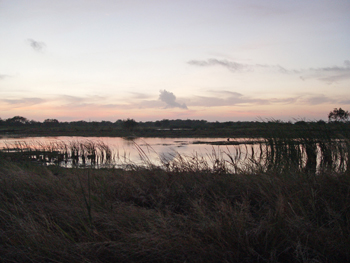
The biggest draw of any night hike is the Striped Bark Scorpion. With the aid of a black light, this predatory arthropod will glow a garish blue in the dark night. These creatures can be found across most of the mid section of the United States north into Illinois as well as through northern Mexico.
By placing a flashlight next to your temple, you will be fascinated by the reflection of hundreds of spider eyes in the grass. Some of these will be tarantulas, but the vast majority will be Wolf Spiders. Among the spiders active at night are Long-jawed Orbweavers, usually found at all the lights, attracted by the insect prey that gathers there.
If the guide took time to erect a black light station before the hike, you might be treated to Vine Sphinx, Rustic Sphinx, and maybe even a Black Witch Moth. Harlequin Flower Beetle and the many species of blister, longhorned and ox beetles (also called the rhinoceros beetle) as well as mole and camel crickets may visit the black light trap.
Mammals are not impossible on a night hike, since Cottontails, Black-tailed Jackrabbits, opossum, raccoons, armadillos, coyotes, bobcats, striped skunk and javelina (also called the collared peccary) are all active night visitors on the grounds. These animals though, are always a surprise when found. Hispid cotton rats and smaller native mice would be nice to see, but are seldom detected.
Bird species, in addition to Eastern Screech-owls, Barred Owls and other owl species that might be found, include Common Pauraques, Common Nighthawks and Lesser Nighthawks. The Pauraques, which are rare throughout the United States, are actually quite common in the park and are frequently found.
A visit to any state park would be incomplete without taking the time to observe some of the herps (reptiles and amphibians) that are moving about, and a night visit can be especially rich. A good night might include Mediterranean Geckos, Rio Grande Chirping Frogs, Leopard Frogs, Couch's Spadefoot (a toad), Texas Toad and Gulf Coast Toad, as well as giant Marine Toads, all attracted by the insects we enjoyed earlier.
And there are always some surprises. A good night might include Rat Snakes poaching on the Pack Rats, Indigo Snakes, Gulf Coast Ribbon Snakes (a subspecies of Western Ribbon Snake), Patch-nosed Snakes, Kissing Bugs and maybe even Unicorn Mantids.
The park does a full moon night hike every full moon, from 8 to 10 pm. If you are visiting the valley and near the park on a full moon, make it a point to join the group.
John is a Park Ranger at Estero Llano Grande State Park in Weslaco.
Birding With Infrared Triggered Cameras
By Billy C. Lambert Jr.
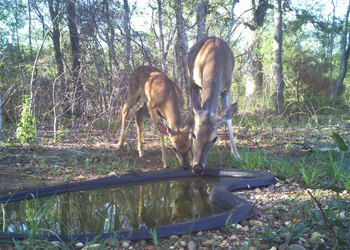
The main problem, it seems, is that birds rarely hold still long enough to get the bird book out and my recollection of identifying features apparently leaves something to be desired (after all, my last ornithology class was some 20 years ago). In the old days, ornithologists would just shoot the bird and then identify it, but that seems a little harsh. Catch-and-release is important when birding.
Many outdoor enthusiasts these days, especially deer hunters, are familiar with infrared-triggered cameras. But, while they have definitely proven useful for deer surveys and to see what is coming to the deer feeder, cameras can also double as a useful tool, especially for identification.
As a case in point, a few months ago I put out a watering device for wildlife on my property. Rather than the traditional-style birdbath, I used a 50 gallon plastic tub and buried it at ground level for a more "natural" presentation. Then, I placed a cinderblock in the tub that sat just under the water level when the tub was full (both for a bath perch and as a way to crawl out if something fell in). Since the tub was located only 20 yards outside my office window, I could easily keep tabs on wildlife visitations.
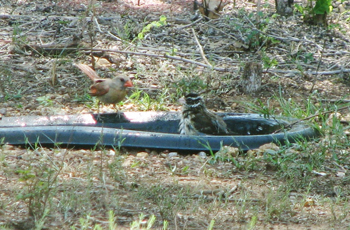
Almost immediately, I noticed substantial use by birds, even more so than I typically saw at a traditional bird bath. There were little green birds, blue birds, yellow and black birds, red birds , multi-colored birds (those are my favorite) and drab little brown birds. As it turns out, I had put the tub out right smack in the middle of the migration and sure enough, there were many that I wasn't familiar with.
A good example was the Rose-breasted Grosbeak with winters outside of the country and breeds from Oklahoma northward, spending very little time in Texas (just during migration). And then there was the Yellow-breasted Chat, a bird that my field guide lists as fairly common all across the US, but had managed to go unidentified by me for 42 years. Regulars at the water also included Painted Buntings and Cedar Waxwings, species I already knew and was familiar with, but never get tired of looking at.
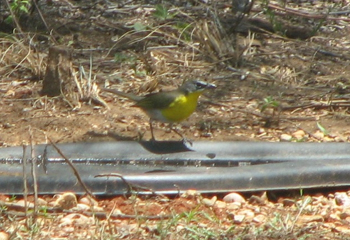
Initially, I kept a digital camera handy and would take several pics when an unknown visitor would show up. Then, with the help of my trusty bird book and a very patient TPWD ornithologist (Cliff Shackelford), I began to identify and learn how to recognize many species that I was previously unfamiliar with. And, I found that since I now had some sort of personal experience with a particular bird, it was much easier to remember identifying features, making it more recognizable in the future.
Wanting to continue to improve upon my learning process, I needed a better way to get close- up photographs rather than take digital pics through a window. Plus, there was always the question of what was coming in when I wasn't looking or when I wasn't in the office. The infrared-triggered camera was the perfect solution to both. I mounted the camera on a stake at ground level about 18 inches from the edge of the tub and the results were even better than I had expected.
Within the first 30 days of using the camera, I had identified (again with the help of Cliff Shackelford) 26 different bird species along with many squirrels, rabbits, fox, raccoons and deer. What started out as simply putting out a watering device for wildlife has now turned into a full-blown obsession with attempting to see how many different species I can document on the property.
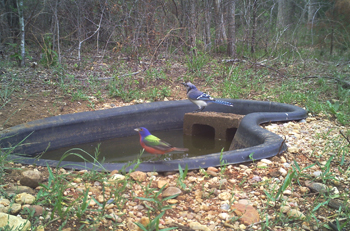
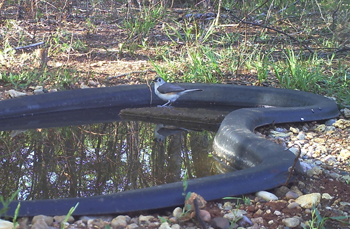
Equipment and expense for the set-up is fairly minimal, especially if you already have the camera. Just about any of the standard cameras on the market today should work fine. I have noticed that the camera I'm using has a fairly slow trigger speed, meaning that some animals come and go without tripping the camera (the small size of the birds may be a factor as well). But, while I may be missing a few individual opportunities, the birds (as well as other animals) usually frequent the water enough to have their photo taken at some point. By setting the camera to trip every minute and to take multiple photographs per event when something is there, I promise you'll end up with many more images than you know what to do with.
Where you place the water/camera will also be important, especially if you are looking for a particular species, as different species utilize different habitat types. My current setup is placed at the edge of an upland wooded area with a thinned understory adjacent to a clearing. Placing the water container in thick woods, bottomland habitat or open grasslands will most likely each result in a different assemblage of birds using the water, which will be important if trying to document as many species as possible.
The camera set up appears to work very well, both for seasoned bird veterans and for those that are just learning. Plus, it may count as a survey technique for those with the wildlife tax valuation. So get out there and get the camera running, you may be surprised at what is out there.
Billy is a Private Lands Biologist with Texas Parks and Wildlife Department working out of Hearne, TX
Hawks of the Night Sky
By Mark Klym
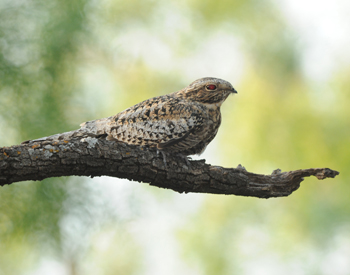
The Common Nighthawk is a fairly common bird that is declining in many of the urban areas of their North American range. They are one of six species of nightjars - medium sized birds that are most active at dusk and dawn looking for flying insects over tree tops, grasslands or cities. All six species nest in Texas, with two of our regional checklists showing all six nesting within the region.
These birds are noted for their amazing ability to "disappear" when they get into leaves and sticks or stones on the ground. Frequently described as "owl like" the nightjars are covered with streaks, spots and blotches of various earth tones that make them "almost impossible" to see once they are on the ground or perched on a branch. Birders have been shocked to find one of these birds sitting quietly inches from their feet. The consistent characters, in addition to the long narrow wings, are the small bill but large wide mouth very appropriate for capturing insects in flight.
The Pineywoods of east Texas is the least diverse region of Texas for nightjars, with only the Common Nighthawk, Chuck-will's widow, and Whip-poor-will being found here. Of these, only the Chuck-wills-widow has been known to nest there. Three regions, the High Plains and Rolling Plains, the Edwards Plateau and the Trans Pecos have recorded five species adding both the Lesser Nighthawk and the Common Poorwill. The Common Pauraque, generally thought of as a South Texas specialty, has been found in both the South Texas Plains and the Oaks and Prairies and Osage Plains regions.
While we often think of owls as the bird of the night, don't pass up an opportunity to see any of the amazing nightjars that are found in Texas.
Mark is the Information Specialist with the Wildlife Diversity Program at Texas Parks and Wildlife Department working out of Austin
From the Back Porch
By Richard Heilbrun
My target was elusive, but not unfamiliar. A female barred owl had been making the rounds, and I hoped to entice her into a conversation. My troops? Eighty five urban Texans with a penchant for adventure. I wasn't sure this was our night, though. Barred owls can hear a rat walking through the grass and can hunt completely by sound. Thanks to frayed edges on the leading edge of their feathers, their flight is completely silent. Those competitive advantages are not fooled by me and 85 people sitting in the darkness on this clear night. My hope though was that the local female might be tempted to ignore the roar of our presence and investigate an unfamiliar owl call.
These folks were attending an Owl Prowl in south San Antonio. They were, by now, familiar with Barred Owls. They knew that barred owls are a familiar urban dweller in central and East Texas, along with screech owls and Great Horned Owls. In East or South Texas, one might even be able to find a Barn Owl, whose eerie calls remind me of a ghostly woman shrieking in the night. The Barred owl, by contrast, has a deeper, not quite hollow 4-syllable call that asks "Who-Cooks-For-You." The Great Horned Owl uses only a 1 note, single syllable call, giving it the common moniker "hoot owl."
Barred owls mostly frequent areas with water, and can be common in urban areas along creeks, rivers, and even linear "green belts" that wind through neighborhoods. Lakes and ponds host owls too, since they provide the prey base and territory needed to thrive. In the city, a Barred Owl's diet is remarkably similar to their country cousins, consisting of rats, mice, and snakes, and they might also enjoy an occasional frog or fish.
The group was quiet now, and I had settled into a rhythm of calling. "Who-cooks-for-you?" Wait. Who-cooks-for-you? Wait. Should I try the more aggressive and hollow sounding "Who-Who-Who-Who-Who" call that they use once they've established a rapport with each other? Not yet. Too soon. Owl calling is delicate business. Call too loudly or too frequently and the resident owls will clam up and find hunting grounds elsewhere. Use a slightly more aggressive "Who-Who-Who-Who-Who" call, and they'll see through my ruse. No real owl would pick a fight before proper introductions. I didn't want to scare them away, but instead aimed only to have a polite conversation.
This event, my annual favorite, was designed to connect people with nature. We have amazing wildlife throughout our cities, and most people are astonished to know of the fantastic creatures that live right here with us. I think the best way to connect with nature is to spend time outside, especially on a cold winter night, and certainly with anybody anxious to learn about wildlife.
The five minutes between calls seemed like an hour, and I heard no response. Cell phones had been turned off, flashlights were hidden, and while I steadied my own breathing, I could sense that my audience was ready for action. In fact, they were getting antsy. I only had one shot really. These owls were approaching their January breeding season, and owl calling can sideline normal hunting or breeding behavior for an entire night. Call too often, or too aggressively, and one could cause home range shifts that disrupt the entire local population.
Then, there she was. A slightly higher pitched "Who-Cooks-For-You.......Who-Cooks-For-Yaaaaaaaaall" (she's a Texan too, after all). She was announcing that she lives here, and any conversation she had with this newcomer would have to be on her terms. But where was she? She called again, essentially asking me to announce myself and make my location known. Most of the time, owls literally meet in the middle, approaching each other and calling gradually, and have some way of knowing who gets to stay and who must leave for the evening.
Our female called from her perch far away to ask "us" to come to her. I called again, desperately trying not to breach any subtle, unknown owl conversation protocol. Almost immediately, she called again, a little closer this time, and just across the river. So I called again, just one time, and a little softer. That must have done the trick, because I heard 85 people gasp as she crossed the river and the full moon illuminated her 43 inch wingspan. As she is silent in flight, we heard only the breaking of twigs as she landed in the oak tree 20 feet above our heads. This too, I have learned, is intentional. It's her way of saying "I'm over here," but without increasing aggression too early, lest she loses the vocal sparring that could result.
But I suppose she was not the patient type this evening, because she soon launched into a quick, repeated series of one-note calls announcing her intention to defend her territory. "Who-Who-Who-Who-Who-Who-Who" she called. She was absolutely stunning, and because she desired to see the intruder, she flew across the opening in the trees twice before settling back over our heads.
Though I wanted our back-and-forth to last longer, I knew that any response from me would escalate our conversation, which could affect her work for the night. She had ignored a throng of people in her territory to stake her claim, and it was hers to keep. As we gathered our belongings and crept away, the now-peaceful river reflected the moonlight up through the bottomland forest. As we departed, so did our owl, anxious to resume her duties. The group buzzed down the trail with a mix of awe and enchantment, and victory was ours.
Richard is Conservation Outreach Program Leader at Texas Parks and Wildlife Department working out of San Antonio.

 Texas Parks and Wildlife Department, 4200 Smith School Road, Austin, TX 78744
Texas Parks and Wildlife Department, 4200 Smith School Road, Austin, TX 78744


